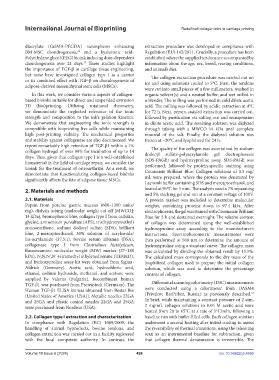Page 506 - IJB-10-6
P. 506
International Journal of Bioprinting Redefined collagen inks in cartilage printing
diacrylate (GelMA-PEGDA) nanospheres enhancing extraction procedure was developed in compliance with
BM-MSC chondrogenesis, and a hyaluronic acid- Regulation (EU) 142/2011. Crucially, a procedure has been
32
Polyethylene glycol (PEG) bioink inducing dose-dependent established where the supplied tendons are accompanied by
chondrogenesis over 21 days. These studies highlight information about the age, sex, breed, rearing conditions,
33
the importance of TGF-β in cartilage tissue engineering, and animal’s diet.
but none have investigated collagen type I as a carrier The collagen extraction procedure was carried out on
or its combined effect with TGF-β on chondrogenesis of ice and using solutions cooled to 5°C. First, the tendons
adipose-derived mesenchymal stem cells (MSCs).
were cut into small pieces of a few millimeters, washed in
In this work, we consider various aspects of collagen- organic solvent(s) and a neutral buffer, and wet milled in
based bioinks suitable for direct and suspended extrusion a blender. The milling was performed in cold dilute acetic
3D (bio)printing. Utilizing rotational rheometry, acid. The milling was followed by acidic extraction at 4°C
we demonstrate the neglected relevance of the ionic for 72 h. Next, pepsin-assisted extraction was carried out,
strength and composition to the ink’s gelation kinetics. followed by purification via salting out and resuspension
We demonstrate that engineering the ionic strength is in dilute acetic acid. The resulting solution was dialyzed
compatible with bioprinting live cells while maintaining through tubing with a MWCO 14 kDa until complete
high post-printing viability. The mechanical properties removal of the salt. Finally, the dialyzed solution was
and stability against collagenase are also documented. We frozen at −20°C and lyophilized for 24 h.
report remarkably high retention of TGF-β1 within a 1% The quality of the collagen was ascertained by sodium
collagen hydrogel of over 99% for incubation of up to 14 dodecyl sulfate-polyacrylamide gel electrophoresis
days. Thus, given that collagen type I is a well-established (SDS-PAGE) and hydroxyproline assay. SDS-PAGE was
biomaterial in the field of cartilage repair, we consider the performed, followed by protein-specific staining using
bioink for the treatment of osteoarthritis. As a result, we
demonstrate that functionalizing collagen-based bioinks Coomassie Brilliant Blue. Collagen solutions of 0.5 mg/
significantly affects the fate of adipose tissue MSCs. mL were prepared, where the protein was denatured by
Laemmli buffer containing SDS and mercaptoethanol, and
2. Materials and methods heated at 95°C for 5 min. The analysis used a 7% separating
and 5% stacking gel and ran at a constant voltage of 100V.
2.1. Materials A protein marker was included to determine molecular
Pepsin from porcine gastric mucosa (600–1200 units/ weights, containing proteins down to 97.4 kDa. After
mg), dialysis tubing (molecular weight cut-off [MWCO]: electrophoresis, the gel was stained with Coomassie Brilliant
14 kDa), bromophenol blue, collagen type I from calfskin, Blue for 2 h and destained overnight. The relative content
glycine, ammonium persulfate (APS), tris(hydroxymethyl) of collagen was determined using the well-established
aminomethane, sodium dodecyl sulfate (SDS), brilliant hydroxyproline assay according to the manufacturer’s
blue, 2-mercaptoethanol, 30% solution of acrylamide/ instructions. Spectrophotometric measurements were
bis-acrylamide (37.5:1), bovine serum albumin (BSA), then performed at 560 nm to determine the amount of
collagenase type I from Clostridium histolyticum, hydroxyproline using a standard curve. The collagen mass
fluorescamine, molecular weight (MW) marker (27–180 was calculated by dividing the obtained result by 13.5%.
kDa), N,N,Nʹ,Nʹ-tetramethyl ethylenediamine (TEMED), The calculated mass corresponds to the dry mass of the
and hydroxyproline assay kit were obtained from Sigma- lyophilized collagen used to prepare the initial collagen
Aldrich (Germany). Acetic acid, hydrochloric acid, solution, which was used to determine the percentage
ethanol, sodium hydroxide, methanol, and acetone were content of collagen.
supplied by Valerus (Bulgaria). Recombinant human
TGF-β1 was purchased from Proteintech (Germany). The Differential scanning calorimetry (DSC) measurements
Human TGF-β1 ELISA kit was obtained from Boster Bio were conducted using a calorimeter from DASM4
34
(United States of America [USA]). Metallic needles 22GA (Privalov; BioPribor, Russia) as previously described.
and 25GA and plastic conical nozzles 22GA and 25GA In brief, while maintaining a constant pressure of 2 atm,
were purchased from Nordson (USA). 2 mg/mL collagen solutions in 0.05 M acetic acid were
heated from 20 to 65°C at a rate of 1°C/min, following a
2.2. Collagen type I extraction and characterization baseline run with buffer-filled cells. Each collagen solution
In compliance with Regulation (EC) 1069/2009, the underwent a second heating after initial cooling to assess
handling of animal byproducts, bovine tendons, and the reversibility of thermal transitions, using the reheating
collagen extraction was carried out in a facility registered scan as an instrumental baseline for subtraction, given
with the local competent authority. In contrast, the that collagen thermal denaturation is irreversible. The
Volume 10 Issue 6 (2024) 498 doi: 10.36922/ijb.4566

